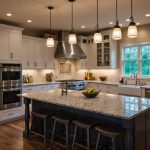Understanding the Importance of Proper Kitchen Lighting
The benefits of kitchen lighting extend far beyond mere illumination. Proper lighting significantly impacts both functionality and ambiance in the kitchen, creating a space that’s efficient and inviting. Good lighting aids in the precision of culinary tasks, ensuring food preparation is safe and accurate. Without sufficient light, chopping or slicing can become hazardous, underscoring the necessity of adequate illumination for safety.
Moreover, lighting plays a critical role in ambiance enhancement. Imagine a warm family dinner under soft, comforting lights versus the harsh glare of an overhead fixture—lighting dramatically alters the dining atmosphere. The choice of lighting can transform the kitchen from a purely functional space into a hospitable venue for social gatherings.
In the same genre : Revamp your family kitchen: the ultimate step-by-step blueprint for embracing a zero-waste lifestyle
Glare reduction also figures prominently. Excessive glare in kitchens can make surfaces appear overly bright or cause discomfort, hindering activities in the space. Balanced lighting solutions mitigate glare, allowing for an inviting environment. By choosing the right fixtures and light placements, you can create an ambiance that offers both aesthetic appeal and practical benefits. Prioritising proper kitchen lighting ultimately involves harmonising utility with welcoming atmospheres, making the space both functional and pleasant.
Techniques for Layering Kitchen Lighting
A thoughtful approach to layered lighting transforms your kitchen into a versatile and attractive space. There are three primary layers to consider: ambient lighting, task lighting, and accent lighting. Ambient lighting provides the general illumination needed for the overall area; think of it as the base layer that fills the room with a warm glow. Recessed lighting or ceiling fixtures often serve this purpose effectively to establish a comfortable baseline.
This might interest you : Transform your kitchen into a serenity sanctuary: expert design tips for boosting mental well-being and relaxation
Task lighting is crucial for areas where precision is required, such as over the countertops or the kitchen island. This type of lighting ensures clarity, making food preparation both safer and more efficient. Under-cabinet lighting installations are common choices, as they direct light precisely where it’s needed while freeing up space above.
Accent lighting highlights architectural features or adds a decorative touch. It might include pendant lights to draw attention to a particular area or LED strips to create subtle visual interest. By seamlessly combining these distinct layers within various kitchen layouts, you can achieve a balanced and dynamic lighting scheme that caters to both functionality and aesthetics, adapting perfectly to any kitchen design.
Choosing the Right Fixtures
Lighting fixtures play a pivotal role in defining your kitchen’s overall ambiance. The blend and selection of fixtures like pendant lights, under-cabinet lighting, and recessed lighting can dramatically transform the space. Each option offers unique benefits, catering to different needs and aesthetic goals.
-
Pendant lights, often used for accent lighting, hang gracefully over kitchen islands and dining areas. They draw attention to specific zones, harmonising the overall ambiance without overwhelming the space. Choose styles and sizes that suit your kitchen’s scale and design.
-
Under-cabinet lighting offers effective task lighting by illuminating countertops and workspaces. These fixtures are crucial for safety, ensuring food preparation areas are well-lit without causing unnecessary shadows or glare. They also add a sleek, modern touch.
-
Recessed lighting provides broad ambient illumination, perfect for evenly covering large kitchen areas. It’s integrated into ceilings to give a clean look while reducing glare when strategically placed.
Proper placement is vital, as it not only enhances functionality but also minimises glare. Combining these fixtures thoughtfully creates a cohesive and inviting atmosphere that prioritises both aesthetics and practicality.
Color Temperature and Its Effect on Kitchen Lighting
Color temperature plays a crucial role in how kitchen lighting affects both the space’s functionality and ambiance. Varying from warm to cool light, each temperature range sets a unique mood. Generally, warm light, ranging from 2700K-3000K, evokes a cozy and inviting atmosphere, ideal for family gatherings or dining areas. In contrast, cool light around 3500K-4100K enhances alertness and visibility, making it suitable for tasks requiring precision, such as chopping or slicing. Balancing these temperatures can enhance specific kitchen zones, offering both utility and comfort.
Choosing the right color temperature involves considering both the kitchen’s layout and purpose. Kitchens with dark countertops may benefit from cooler tones to improve contrast, whereas lighter surfaces might favor warmer hues for a harmonious look. Importantly, your bulb choice should support a blend of temperatures to tackle potential glare issues, preventing overly harsh or contrasting light that could distort your kitchen’s aesthetic.
Ultimately, understanding and implementing appropriate color temperatures can significantly influence the kitchen’s overall feel and function, allowing the space to adapt to varying needs and preferences while maintaining an inviting environment.
Identifying and Solving Common Glare Issues
Glare can considerably impact the usability and comfort of a kitchen space. Reflective surfaces and poorly positioned light sources are common culprits. Glare often arises from excessive light bouncing off glossy worktops or shiny appliances. This not only becomes visually uncomfortable but can also hinder activities like food preparation. To tackle these issues, it’s crucial to implement effective lighting solutions.
One strategy is to opt for matte finishes on surfaces to reduce reflection. Additionally, choosing fixtures with diffusers or shields can help by softening the light and dispersing it evenly. Adjustable lighting, such as dimmable lamps or lights with movable heads, allows users to modify the intensity and direction based on specific tasks, mitigating glare at its source.
Selecting the right types of lighting fixtures also plays a pivotal role. Under-cabinet lighting directly illuminates countertops, minimizing the chances of reflection. Recessed lighting, strategically placed, offers broad ambient illumination without direct eye exposure. Ultimately, tailoring the lighting design to suit the kitchen layout can significantly alleviate glare, ensuring the kitchen remains both functional and welcoming.
Adapting Lighting to Different Kitchen Styles
The distinct aesthetics of kitchen styles directly influence lighting choices. In modern kitchens, sleek and minimalist fixtures such as stainless steel pendant lights and recessed lighting often harmonise the clean lines and open spaces, providing both function and flair. Adopting a streamlined approach with a touch of innovation is key in these environments.
For traditional kitchens, opting for fixtures with intricate designs can enhance the classic appeal. Chandeliers or ornate pendants often add a touch of elegance, enriching the overall ambiance with a warm, inviting glow. These fixtures complement the rich textures and timeless character typically found in traditional settings.
In eclectic kitchens, mixing and matching diverse fixtures like vibrant pendants or quirky lamps can create a visually stimulating environment. The goal here is personalisation—allowing your kitchen to exude personality through varied, bold lighting choices.
When selecting lighting, it’s essential to consider how each style reflects your preferences, ensuring that practicality meets personal expression. Effective use of layers, incorporating task and ambient lighting, can seamlessly integrate function with style across different kitchen designs. Tailoring your kitchen lighting to specific styles not only enhances its visual appeal but also ensures a cohesive and functional space.
Practical Visual Examples and Diagrams
Utilizing lighting diagrams and practical examples can significantly enhance understanding of kitchen lighting concepts. Visual guides illustrate how layered lighting contributes to functionality and style. These representations clarify how ambient lighting forms the base, illuminating the room evenly, while task lighting focuses brightness on work areas. For instance, imagine a kitchen diagram where under-cabinet lighting brightens countertops for efficient meal prep, reducing shadows and glare effectively.
Visual examples of kitchen lighting layouts offer tangible insights into fixture placement for different kitchen styles. In a modern kitchen, diagrams might showcase sleek pendant lights over an island to deliver stylish, focused illumination. Alternatively, a traditional kitchen layout could feature ornate chandeliers, enhancing classic ambiance with warmth. These visuals aid in personalising lighting designs, ensuring each fixture aligns with individual kitchen aesthetics.
Diagrammatic representation is particularly beneficial for those planning to optimise their kitchen’s illumination. Clear illustrations of light layering and fixture types facilitate informed decisions, ultimately promoting a harmonious blend of aesthetics and practicality. Through these illustrative tools, homeowners can envision and implement lighting strategies that transform their kitchens into inviting spaces.











